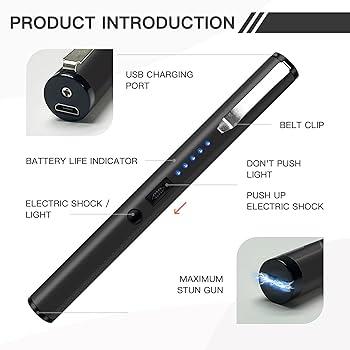Table of Contents
- Understanding the Risks of Overcharging Your Stun Gun Battery
- Choosing the Right Charger for Optimal Battery Health
- Implementing Proper Charging Cycles and Duration
- Monitoring Battery Temperature and Voltage During Charging
- Final Thoughts
Understanding the Risks of Overcharging Your Stun Gun Battery
Overcharging your stun gun battery can significantly reduce its overall lifespan and performance. When a battery is charged beyond its optimal capacity, it generates excess heat, which may lead to internal damage and reduced efficiency. In some cases, this overheating can cause the battery to swell, leak, or even fail unexpectedly, leaving you without protection when you need it most. Additionally, prolonged overcharging increases the risk of battery corrosion and short circuits, which compromises both safety and functionality.
To avoid these risks, it’s essential to understand how your stun gun’s charging system works and follow manufacturer guidelines carefully. Consider these tips for safe battery maintenance:
- Use the original charger provided to ensure compatibility
- Charge the stun gun in a cool, well-ventilated area to prevent overheating
- Disconnect the charger once the battery reaches 100% capacity
- Avoid leaving your stun gun plugged in overnight or for extended periods
By respecting these best practices, you not only extend the life of your battery but also maintain the device’s reliability when self-defense matters the most.
Choosing the Right Charger for Optimal Battery Health
Selecting the appropriate charger for your stun gun battery is essential to maintain its longevity and avoid the risks associated with overcharging. Not all chargers are created equal; using a charger specifically designed for your stun gun model ensures that the voltage and current supplied are within safe limits. Look for chargers with built-in overcharge protection, automatic shut-off features, and compatibility with your battery’s voltage requirements. These advanced safety features are crucial in preventing overheating, swelling of the battery, or permanent damage to the internal cells.
When evaluating your options, consider these factors to make an informed choice:
- Compatibility with your stun gun’s battery type (Li-ion, NiMH, etc.)
- Presence of smart charging technology that adjusts power delivery based on battery status
- Certified safety standards like UL or CE marks ensuring quality assurance
- Durable build quality and reliable brand reputation
Implementing Proper Charging Cycles and Duration
To maintain optimal battery health, it’s essential to adhere to recommended charging protocols. Batteries in stun guns are designed to be charged for a specific duration-usually between 4 to 6 hours. Exceeding this period can cause the battery to overheat and degrade prematurely, while charging for too short a time may result in incomplete charging cycles, reducing operational efficiency. Use the charger provided by the manufacturer and always monitor the charging process to ensure the device is not left plugged in overnight or unattended for extended periods.
Incorporating structured charging habits can prolong your stun gun’s battery life significantly. Consider implementing these tips:
- Charge only when the battery is low: Avoid frequent top-ups to prevent voltage stress.
- Disconnect immediately after full charge: Many modern chargers include LED indicators to signal completion.
- Perform regular battery maintenance: Periodically discharge the battery before recharging to recalibrate its capacity.
Monitoring Battery Temperature and Voltage During Charging
Keeping a close eye on your stun gun’s battery temperature and voltage during charging is crucial to avoid overcharging and potential damage. Batteries naturally heat up when charged, but excessive heat can signal a malfunction or an imminent overload. Utilize a reliable charger with built-in thermal sensors or pair your setup with an external thermometer designed for batteries. If you notice the battery temperature rising significantly beyond the manufacturer’s recommended limits-typically around 40°C to 45°C (104°F to 113°F)-disconnect it immediately to prevent overheating and possible failure.
Voltage fluctuations are another critical indicator of battery health during charging. Employ a multimeter or a charging station with voltage monitoring features to track voltage levels in real-time. Normal voltage increments should be stable and gradual. Sudden spikes or drops may indicate a faulty battery or charger. When monitoring your stun gun’s charging process, watch for these key signs:
- Steady voltage rise: A consistent voltage increase shows a healthy charge cycle.
- Stable temperature: Temperature should remain within safe limits without sudden increases.
- Alert notifications: Use chargers with automatic cut-offs or alarms for abnormal readings.
Final Thoughts
In conclusion, properly maintaining your stun gun battery is essential not only for ensuring optimal performance but also for extending its overall lifespan. By following safe charging practices-such as using the recommended charger, monitoring charging times, and avoiding overcharging-you can protect your device from potential damage and stay prepared when you need it most. Remember, a well-cared-for stun gun battery is a reliable one, so invest the time in safe charging habits to keep your device ready and effective. Stay safe, stay informed, and always prioritize battery health for peace of mind.Check Our Other Blogs
- StunGun – Your Trusted Source for Stun Guns, Laws, and Self-Defense Tips
- PepperSprayLaws – Your Trusted Resource for Pepper Spray Information
- StunGunLaws – Your Trusted Guide to Stun Gun Legality and Safety





